Paper Details


Call For Papers
Volume 06, Issue 11
Frequency: 12 Issue per year
Paper Submission: Throughout the Month
Acceptance Notification: Within 2 days
Areas Covered: Multidisciplinary
Accepted Language: Multiple Languages
Journal Type: Online (e-Journal)
Announcement

Publish books with ISBN Number
- Edited Book
- Text Book
- Ph.D Thesis
- Conference Proceedings
ISSN Number:
2582-8568
Journal DOI No:
03.2021-11278686
Title:
INDIAN POLITICS OF PLANNED DEVELOPMENT
Authors:
Cite this Article:
,
INDIAN POLITICS OF PLANNED DEVELOPMENT , International Research Journal of Humanities and Interdisciplinary Studies (www.irjhis.com), ISSN : 2582-8568, Volume: 6, Issue: 5, Year: May 2025, Page No : 309-315,
Available at : http://irjhis.com/paper/IRJHIS2505029.pdf
Abstract:
In This research critically analyzes the political dimensions of planned development in India, tracing its trajectory from the post-independence era to the present. It investigates how political ideologies, power dynamics, and electoral imperatives have shaped India's development strategies, focusing on the evolution from the Nehruvian model of centralized planning to the contemporary paradigm embodied by NITI Aayog. The study examines the political influences on the Five-Year Plans, the socio- economic and political implications of the Green Revolution, the transformative impact of the 1991 liberalization, and the rationale behind the Planning Commission's transition to NITI Aayog. By employing a qualitative approach, drawing upon historical documents, policy analyses, and scholarly literature, this research seeks to illuminate the intricate interplay between politics and development in India. It addresses key questions: How did political ideologies shape the initial phase of planned development? How did political shifts influence the objectives and outcomes of the Five-Year Plans? What were the political consequences of the Green Revolution and the 1991 liberalization? How does the transition to NITI Aayog reflect evolving political priorities? This study contributes to a nuanced understanding of India's developmental journey, offering valuable insights for future policy formulation and highlighting the enduring significance of political factors in shaping socio-economic outcomes
Keywords:
Planning Commission, Five-Year Plans, Nehruvian socialism, liberalization, mixed economy,
Publication Details:
Published Paper ID: IRJHIS2505029
Registration ID: 21888
Published In: Volume: 6, Issue: 5, Year: May 2025
Page No: 309-315
ISSN Number: 2582-8568
Download Full Paper: Click Here
Article Preview:





